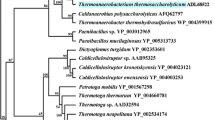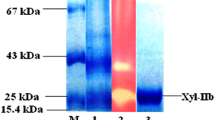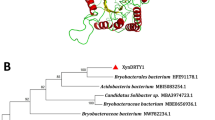Abstract
The Clostridium acetobutylicum xylanase gene xyn10B (CAP0116) was cloned from the type strain ATCC 824, whose genome was recently sequenced. The nucleotide sequence of C. acetobutylicum xyn10B encodes a 318-amino acid protein. Xyn10B consists of a single catalytic domain that belongs to family 10 of glycosyl hydrolases. The enzyme was purified from recombinant Escherichia coli. The Xyn10B enzyme was highly active toward birchwood xylan, oat-spelt xylan, and moderately active toward avicel, carboxymethyl cellulose, polygalacturonic acid, lichenan, laminarin, barley-β-glucan and various p-nitrophenyl monosaccharides. Xyn10B hydrolyzed xylan and xylooligosaccharides to produce xylobiose and xylotriose. The pH optimum of Xyn10B was 5.0, and the optimal temperature was 70°C. The enzyme was stable at 60°C at pH 5.0–6.5 for 1 h without substrate. This is one of a number of xylan-related activities encoded on the large plasmid in C. acetobutylicum ATCC 824.



Similar content being viewed by others
References
Ali BRS, Romaniec MM, Hazlewood GP, Freedman RB (1995) Characterization of the subunits in an apparently homogeneous subpopulation of Clostridium thermocellum cellulosomes. Enzyme Microb Technol 17:705–711
Ali MK, Fukumura M, Sakano K, Karita S, Kimura T, Sakka K, Ohmiya K (1999) Cloning, sequencing, and expression of the gene encoding the Clostridium stercorarium xylanase C in Escherichia coli. Biosci Biotechnol Biochem 63:1596–1604
Biely P (1985) Microbial xylanolytic systems. Trends Biotechnol 3:286–290
Bradford MM (1997) A rapid and sensitive method for the quantitation of microgram quantities of protein utilizing the principal of dye binding. Anal Biochem 86:142–146
Coutinho PM, Henrissat B (1999) Carbohydrate-active enzymes: an integrated database approach. In: Recent advances in carbohydrate bioengineering. Royal Society of Chemistry, Cambridge, pp 3–12
Derewenda U, Swenson L, Green R, Wei Y, Morosoli R, Shareck F, Kluepfel D, Derewenda ZS (1994) Crystal structure at 2.6-Å resolution, of the Streptomyces lividans xylanase A, a member of the F family of β-1,4-d-glycanases. J Biol Chem 269:20811–20814
Grohmann K, Wymann CE, Himmel ME (1992) Potential for fuels from biomass and waste. In: Rowell RM, Schults TP, Narayan R (eds) Emerging technologies for materials and chemicals from biomass. American Chemical Society, Washington, D.C., pp 354–392
Henrissat B, Bairoch A (1960) Updating the sequence-based classification of glycosyl hydrolases. Biochem J 316:695–696
Karlsson NE, Roxa EB, Holst O (1997) Cloning and sequence of a thermostable multidomain xylanase from the bacterium Rhodothermus marinus. Biochim Biophys Acta 1353:118–124
Karlsson NE, Dahlberg L, Torto L, Gorton L, Holst O (1998) Enzymatic specificity and hydrolysis pattern of the catalytic domain of the xylanase Xyn1 from Rhodothermus marinus. J Biotechnol 60:23–35
Katsube Y, Hata Y, Yamaguchi H (1990) Estimation of xylanase active site from crystalline structure. In: Ikehara M (ed) Protein engineering, Japan Scientific Societies Press, Tokyo, pp 91–96
Keis S, Bennett CF, Ward VK, Jones DT (1995) Taxonomy and phylogeny of industrial solvent-producing clostridia. Int J Syst Bacteriol 45:693–705
Kim H, Jung KH, Pack MY (2000) Molecular characterization of XynX, a gene encoding a multidomain xylanase with a thermostabilizing domain from Clostridium thermocellum. Appl Microbiol Biotechnol 54:521–527
Kulkarni N, Shendye A, Rao M (1999) Molecular and biotechnological aspects of xylanases. FEMS Microbiol Rev 23:411–456
Laemmli UK (1970) Cleavage of structural proteins during the assembly of the head of bacteriophage T4. Nature 227:680–685
Lawson SL, Wakarchuck MW, Withers SG (1997) Positioning the acid/base catalyst in a glycosidase: studies with Bacillus circulans xylanase. Biochemistry 36:2257–2265
Lee SF, Forsberg CW, Gibbins LN (1985) Xylanolytic activity of Clostridium acetobutylicum. Appl Environ Microb 50:1068–1076
Lee SF, Forsberg CW, Rattray M (1987) Purification and characterization of two endoxylanases from Clostridium acetobutylicum ATCC 824. Appl Environ Microbiol 53:644–650
Lo Leggio L, Kalogiannis S, Bhat MK, Pickersgill RW (1999) High resolution structure and sequence of T. aurantiacus xylanase I: implications for the evolution of thermostability in family 10 xylanases and enzymes with (beta) alpha-barrel architecture. Proteins 36:295–306
Lo Leggio L, Kalogiannis S, Eckert K, Teixeira SCM, Bhat MK, Andrei C, Pickersgill RW, Larsen S (2001) Substrate specificity and subunit mobility in T. aurantiacus Xylanase 10A. FEBS Lett 509:303–308
Miller GL (1959) Use of dinitrosalicylic acid reagent for determination of reducing sugar. Anal Chem 31:426–428
Nolling JG, Breton G, Omelchenko MV, Makarova KS, Zeng Q, Gibson R, Lee HM, Dubois J, Qiu D, Hitti J, Wolf YI, Tatusov RL, Sabathe F, Doucette-Stamm L, Soucaille P, Daly MJ, Bennett GN, Koonin EV, Smith DR (2001) Genome sequence and comparative analysis of the solvent producing bacterium Clostridium acetobutylicum. J Bacteriol 183:4823–4838
Ohmiya K, Sakka K, Karita S, Kimura T (1997) Structure of cellulases and their applications. Biotechnol Genet Eng Rev 14:365–414
Stackebrandt E, Rainey FA (1997) Phylogenetic relationships. In: Rood J, McClane BA, Songer JG, Titball RW (eds) The Clostridia: molecular biology and pathogenesis. Academic, San Diego pp 3–19
Stackebrandt E, Kramer IJ, Swiderski J, Hippe H (1999) Phylogenetic basis for a taxonomic dissection of the genus Clostridium. FEMS Immunol Med Microbiol 24:253–258
Teather RM, Wood PJ (1982) Use of Congo red-polysaccharide interactions in enumeration and characterization of cellulolytic bacteria from the bovine rumen. Appl Environ Microbiol 43:777–780
Timell TE (1967) Recent progress in the chemistry of wood hemicelluloses. Wood Sci Technol 1:45–70
Tomme P, Warren AJ, Miller RC Jr, Kilburn DG, Gilkes NR (1995) Cellulose-binding domains-classification and properties. In: Sadder JM, Penner M (eds) The enzyme degradation of insoluble polysaccharides. American Chemical Society, Washington, D.C. pp 142–162
Viikari L, Tenkanen M, Buchert J, Ratto M, Baily M, Siikaho M, Linko M (1993) Hemicelluloses for industrial applications. In: Saddler JN (ed) Bioconversion of forest and agricultural plant residues. CAB, Oxford, pp 131–182
Wong KKY, Saddler JN (1992) Trichoderme xylanases: their properties and application. In: Visser J, Beldman G, Spmeren MAK, Voragen AGJ (eds) Xylans and xylanases. Elsevier, Amsterdam, pp 171–186
Wong KKY, Tan LUL, Saddler JN (1988) Multiplicity of β-1,4-xylanase in microorganisms: functions and application. Microbiol Rev 52:305–317
Wood WA, Bhat KM (1988) Methods for measuring cellulase activities. Methods Enzymol 160:87–112
Woods DR (ed) (1993) The clostridia and bio/technology. Butterworth-Heinemann, Boston
Zeikus JG, Lee C, Lee YE, Shaha BC (1991) Thermostable saccharidases: new sources, uses and biodesign. In: Leatham GF, Himmel ME (eds) Enzymes in biomass conversion. American Chemical Society, Washington, D.C., pp 36–51
Acknowledgements
This research was supported by the United States Department of Agriculture grant, 00-35500-926 and Robert A. Welch Foundation grants C-1268 and C-1372.
Author information
Authors and Affiliations
Corresponding author
Rights and permissions
About this article
Cite this article
Ali, M.K., Rudolph, F.B. & Bennett, G.N. Thermostable xylanase10B from Clostridium acetobutylicum ATCC824. J IND MICROBIOL BIOTECHNOL 31, 229–234 (2004). https://doi.org/10.1007/s10295-004-0143-8
Received:
Accepted:
Published:
Issue Date:
DOI: https://doi.org/10.1007/s10295-004-0143-8




